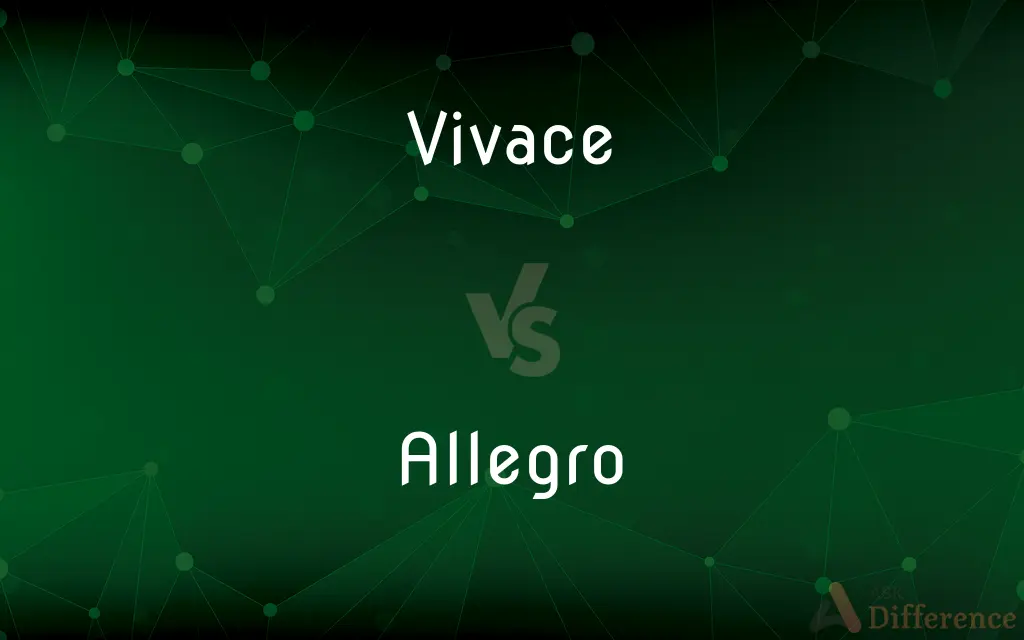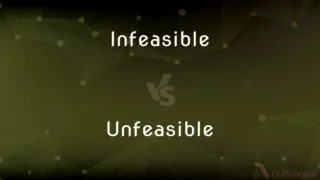Vivace vs. Allegro — What's the Difference?
By Fiza Rafique & Urooj Arif — Updated on April 15, 2024
Vivace, meaning lively and fast, typically ranges between 156 and 176 BPM, while Allegro, also quick but slightly broader, spans from 120 to 168 BPM.

Difference Between Vivace and Allegro
Table of Contents
ADVERTISEMENT
Key Differences
Vivace is an Italian musical term that translates to "lively" and suggests a tempo that is very fast and vibrant. Whereas, Allegro, another Italian term, means "cheerful" or "brisk" and indicates a quick and energetic tempo, but not as rapid as vivace.
In terms of beats per minute (BPM), vivace typically falls within the range of 156 to 176 BPM, emphasizing a very spirited and quick pace. On the other hand, Allegro covers a broader range from about 120 to 168 BPM, making it versatile for various lively compositions without reaching the intensity of vivace.
Vivace is often used in music to convey a sense of enthusiasm and rapid movement, ideal for pieces that require a high level of technical prowess from the performers. Whereas, Allegro is generally used to set a joyful and active mood, suitable for a wide array of musical genres and contexts.
Composers choose vivace to intensify the excitement and drive of a piece, making it feel more dynamic and animated. While Allegro may also carry a joyful feel, it provides a slightly more relaxed pace compared to vivace, thus offering a different kind of energy.
Vivace and Allegro both enhance the expressive quality of a piece, but vivace does so with a more urgent and lively approach, pushing the boundaries of speed in music. Allegro, though also fast, allows for a more moderate tempo that can be sustained over longer passages.
ADVERTISEMENT
Comparison Chart
Meaning
Lively, vibrant
Cheerful, brisk
BPM Range
156-176 BPM
120-168 BPM
Energy Level
Very high, intense
High, but more moderate
Typical Usage
Quick, enthusiastic sections
Broad range of lively pieces
Technical Demand
High, requires precision
Moderate, versatile
Compare with Definitions
Vivace
Associated with a bright and animated performance.
The soloist’s vivace performance was both technically impressive and emotionally captivating.
Allegro
Suitable for expressing a range of joyful emotions.
His allegro passages are always filled with a sense of playfulness and excitement.
Vivace
Very fast and lively tempo in music.
The symphony's third movement was marked vivace, challenging the musicians to keep up with the brisk pace.
Allegro
Often used as the first movement in sonatas and symphonies.
The symphony opened with an allegro pace, setting a joyful tone for the evening.
Vivace
Used to describe a piece that is performed in a spirited manner.
Her rendition of the piano sonata was vivace, filled with energy and precision.
Allegro
Indicates a lively but not overly fast speed.
The allegro section was executed with perfect balance between speed and clarity.
Vivace
Indicates a tempo faster than allegro in musical terminology.
For the final act, the conductor directed the orchestra in a vivace tempo.
Allegro
Broadly applied across various musical styles.
From baroque to contemporary, allegro remains a favorite for composers and performers alike.
Vivace
Implies a sense of enthusiasm and speed.
The quartet played the vivace section with great enthusiasm and skill.
Allegro
Describes a quick and cheerful musical tempo.
The allegro movement of the concerto brought an uplifting spirit to the concert hall.
Vivace
In a lively or vivacious manner. Used chiefly as a direction.
Allegro
In a quick, lively tempo, usually considered to be faster than allegretto but slower than presto. Used chiefly as a direction.
Vivace
(music) At a brisk, lively tempo.
Allegro
An allegro passage or movement.
Vivace
(music) Played, or to be played, at a brisk, lively tempo.
Allegro
A succession of fast jumps performed as an exercise in ballet.
Vivace
(music) A piece to be played at a brisk, lively tempo.
Allegro
(music) A tempo mark directing that a passage is to be played in a quick, lively tempo, faster than allegretto but slower than presto.
Vivace
Brisk; vivacious; with spirit; - a direction to perform a passage in a brisk and lively manner.
Allegro
An expressive mark indicating that a passage is to be played in a lively or happy manner, not necessarily quickly.
Vivace
(of tempo) very fast and lively
Allegro
(music) A passage having this mark.
Vivace
Lively, in music;
Play this section vivace!
Allegro
(music) played in a quick, lively tempo
Allegro
(music) in a quick and lively manner
Allegro
Brisk, lively.
Allegro
A brisk and lively tempo
Allegro
A musical composition or passage performed quickly in a brisk lively manner
Allegro
(of tempo) fast
Allegro
In a quick and lively tempo;
Play this section allegro
Common Curiosities
What is the BPM range for vivace?
Vivace typically ranges from 156 to 176 BPM.
Can allegro and vivace be used interchangeably in music?
While both indicate a fast tempo, vivace is usually faster and more intense, so they are not interchangeable.
What is the emotional impact of using allegro in a musical piece?
Allegro brings a cheerful and energetic mood to the music.
What type of music commonly uses vivace?
Vivace is commonly used in fast, lively, and technically demanding pieces.
How does allegro differ from vivace in terms of speed?
Allegro ranges from 120 to 168 BPM, making it generally slower than vivace.
Are there any famous pieces that feature vivace prominently?
Many classical symphonies and virtuoso solos feature vivace sections.
What skills are required to perform an allegro section effectively?
Good control over tempo and dynamics is essential for performing allegro effectively.
Is vivace suitable for beginners?
Due to its fast pace, vivace is more challenging and might not be suitable for beginners.
Does vivace affect the overall length of a musical piece?
Yes, faster tempos like vivace can shorten the duration of sections.
What instruments excel in vivace passages?
Instruments like the violin, piano, and flute excel in vivace due to their ability to produce rapid notes.
Does the choice of allegro or vivace affect the conductor's approach?
Yes, the conductor must adjust the orchestra's playing style and technique based on the tempo marking, whether it's allegro or vivace.
How do composers decide between using allegro and vivace?
The choice depends on the desired energy, speed, and mood of the piece.
Is there a historical context to the use of vivace in music?
Vivace has been a popular tempo marking since the Baroque era, emphasizing speed and precision.
Can allegro be used in both fast and slow movements?
Allegro is typically used in faster movements but can be adapted for moderately fast sections as well.
How does the audience typically react to allegro?
Audiences often react positively to allegro, enjoying its lively and engaging rhythm.
Share Your Discovery

Previous Comparison
Doormat vs. Pushover
Next Comparison
Infeasible vs. UnfeasibleAuthor Spotlight
Written by
Fiza RafiqueFiza Rafique is a skilled content writer at AskDifference.com, where she meticulously refines and enhances written pieces. Drawing from her vast editorial expertise, Fiza ensures clarity, accuracy, and precision in every article. Passionate about language, she continually seeks to elevate the quality of content for readers worldwide.
Co-written by
Urooj ArifUrooj is a skilled content writer at Ask Difference, known for her exceptional ability to simplify complex topics into engaging and informative content. With a passion for research and a flair for clear, concise writing, she consistently delivers articles that resonate with our diverse audience.














































